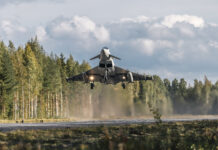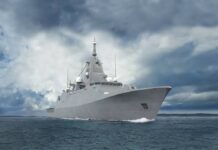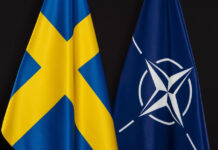Finland, Europe’s most northern state, defines its maritime policy according to the parameters dictated by its geography and climate. With a 675nm (1,250 km) long coastline, jagged by a maze of over 81,000 islands, rocks and shoals, the Finnish Navy combines highly mobile forces backed up with minelaying capabilities. Finland is under no illusions about the security challenges in the region.
The Finnish Navy is organised into the Navy Command, headquartered in Turku; the Coastal Fleet, comprising all the operational combat vessels and auxilliaries, operating from two naval base: (Pansio in the Archipelago Sea and Kirkkonummi in the Gulf of Finland); the Coastal Brigade, headquartered in Kirkkonummi; the Nyland Brigade, with headquarters in Raasepori and the Naval Academy, located in the Suomenlinna Sea Fortress, a small island off Helsinki. As of end-2019, the Navy employed 1212 personnel (471 officers, 218 warrant officers and 523 NCOs), as well as an additional 203 civilians and about 3200 conscripts. Most of the conscripts are assigned to the coastal defence brigades and only some 20% serves onboard the ships.
In 2019, Finland’s total defence budget amounted to €3.138Bn of which the Finnish Navy received approximately €774.5M.
Tasks and Missions
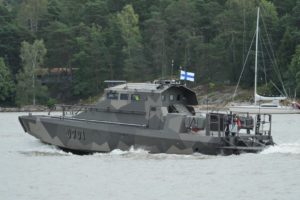
The small but powerful Finnish Navy plays a central role in supporting the country’s interests. The navy’s core mission is homeland defence, enforcing control and support in territorial and EEZ waters, monitoring maritime traffic, search and rescue, and executing any missions required by the Government in close cooperation with the Army, Air Force and Border Guard. The resurgence of the Russian Navy has placed the northern waters, and the Baltic Sea in particular, back on the front line. When operating in the territorial waters, the ships’ commanding officers have rules-of-engagement that give them the right to go through warning procedures and force a vessel to act as required, without having to seek permission from the Finnish MoD. Although homeland defence remains the Finnish Navy’s primary task, the increase of missions in support of crisis management and asymmetric threats maritime challenges have been brought forward too.
Force Levels
The Finnish Navy operates a fleet of fast missile attack craft, minehunting and minelaying vessels, along with numerous auxiliaries and smaller craft. The heart of the service’s strike capabilities are the four RAUMA class and the four HAMINA class fast missile attack craft.
Built in the early 1990s, the 240-tonne RAUMA class units received a €70M mid-life upgrade (MLU) from 2010 to 2013, allowing the vessels to remain in service well into the 2020s. This modernisation entailed the installation of Saab’s 9LV Mk 4 combat management system, a Simrad ST2400 variable depth sonar, an Ericsson SEA GIRAFFE radar, a Bofors Electronic’s 9LV 225 fire control radar; a Furono navigation radar and two Rheinmetall MASS decoy systems. The RAUMA class units have proven to be well suited for our needs, and we have not experienced any major difficulties or technical failures with them, even though their operational profile has been very active.

The 274-tonne HAMINA class fast missile attack craft, commissioned between August 1998 and June 2006, is currently undergoing a major modification estimated at €190M and known as the ‘Squadron 2000 MLU’. Scheduled to be completed by2023, it will allow the navy to keep them in operation well into the 2030s. The upgrade focuses on the installation of a new Saab 9LV combat management system, a TactiCall communication system, and Israel Aerospace Industries (IAI) Elta electronic warfare suite, a TRACKFIRE remote weapon station, a Kongsberg ST2400 variable depth sonar, Saab Dynamic’s New Lightweight Torpedos and the replacement of the RBS-15F missiles by the IAI Gabriel’s SSM2020 missile system. In addition, the Airbus Defence and Space TRS-3D radar and CEROS 200 fire-control radar are upgraded, the Bofor 57mm Mk3 guns replaced with the lighter Bofors 40mm Mk4 guns, MASS chaff launchers and the integration of Link 16 and Link 22 and the installation of larger fuel tanks. All four units are planned to be operational again in 2024.
Mine Warfare
With mine warfare operations a central element, the Finnish Navy’s inventory includes several minecountermeasure platforms. The latest addition are the three KATANPÄÄ class units. First-of-class KATANPÄÄ was formally delivered on 4 May 2012, the second – PURUNPÄÄ, and the third VAHTERPÄÄ entered the fleet on 20 August 2013 and 2 November 2016, respectively.
The vessels minewarfare toolbox comprises the Saab Underwater Systems’ reusable DOUBLEEAGLE Mk III, Atlas Elektronik SEAFOX Combat (SEAFOX C) and reusable Identification (SEAFOX I) ROVs, a L3 Klein 5500 towed sidescan sonar, the Kongsberg Hydroid REMUS 100 and HUGIN 1000 MR. These MCM systems have a high degree of commonality with the systems onboard the Swedish, Belgian, Dutch and German navies` MCMVs. All three units are set to be Fully Operational Capable (FOC) in 2020.
The sea service’s other minecountermeasure assets include four KIISKI class inshore minesweepers built in 1984, and three 1974-vintage KUHA class inshore minesweepers, the latter having been modernized between 1998 and 2002. There are plans to replace the influence and contact minesweeping capability around mid-2020. Whether or not this means a complete decommissioning of KUHA and KIISKI classes remains to be seen. The naval staff is looking into different possibilities to replace this capability with an integrated remotely controlled minesweeping system and closely monitors the results of any of the European Defence Agency’s technology demonstrator projects, in which the Finnish Navy also participates.
Another crucial element in the Finnish Navy is its minelaying capability. The narrow, shallow straits and myriad islets are highly suitable for minelaying, hence most of the naval vessels featuring a minelaying capability. The mainstay of the fleet’s minelaying assets are the two HÄMEENMAA class and three PANSIO class minelayers.

FNS HÄMEENMAA and FNS UUSIMA, inducted into the fleet in April and December 1992 respectively, received a major upgrade between 2006 and 2008 that included the installation of: a Denel UMKHONTO VLS missile system, an EADS ANCS 2000 combat management system, a TRS 3-D radar, a Simrad SS2030 hull-mounted sonar and a Kongsberg ST2400 VDS, two quintuple RBU-1200 A/S launchers, a Thales integrated early-warning system, a SAAB CEROS weapon control system and a communications suite, a flight deck and new combat information centre and two new mast to accommodate the expanded sensor and communication systems. This upgrade made the minelayers suited for international missions beyond the Baltic. The other minelayers are the three ice-strengthened 460-tonne PANSIO class landing craft utility (LCU) minelayers,PANSIO, PORKKALA and PYHÄRANTA. Having joined the fleet in the early 1990s, they underwent an overhaul in order to keep them in service well into the 2020s.
This modernisation programme consisted of the installation of a new combat management system and satellite communications system, a new electro-optical system, a new Doosan-MAN diesel engines. The service operates various auxiliaries, small landing craft and service launches. With one of its tasks being also the control of marine pollution, the navy operates three pollution control vessels: the 71.4-metre-long LOUHI, the largest oil spill recovery ship in the Baltic region, and the 64-metre-long HALLI and HYLJE. The fleet’s other assets include 12 JEHU class, 36 JURMO class and some 30 MERIUISKO class assault craft, and the 35 G-class raiding craft, two ASKERI class and four SYÖKSY class command launches, LOKKI class training vessel KAJAVA, the LCU transport craft KAMPELA 3, two VALAS class transport craft, the diver support platform ISKU, three FABIAN WREDE class training vessels for the Naval Academy and one harbor tug KALLANPÄÄ. The Finnish Navy stocks also a variety of mines: S/43 and S/58 anchored electromagnetic anti-surface warfare contact mines, PM/83 and PM/83-2 acoustically influenced anti-surface warfare and anti-submarine warfare acoustic/magnetic bottom mines and PM/85 acoustic/magnetic mines with pressure-influence settings.
The ‘Squadron 2020’ Project
The increasingly strategic value of the Baltic Sea as a potential theatre of military conflict has triggered steps by the Finnish Government and the MoD to bolster the sea service’s surface and anti-submarine capabilities. Central to this new vision is the ‘Squadron 2020′ (‘’Laivue 2020’) Corvette Programme, launched by the MoD on 25 September 2015 and covering the procurement of four new corvettes to replace the four RAUMA class missile attack craft and two HÄMEENMAA class minelayers. On 28 April 2017, the Finnish Defense Forces signed a design contract with RAUMA for the hull design and, in October 2017, Deltamarin was awarded a contract for the basic design of the deck outfitting and machinery, with all work being conducted at RAUMA’s facilities.

Known as the POHJANMAA class, the corvettes will have an estimated length of 115 metres, a displacement of around 3900 tonnes, and feature anti-surface, anti-air and anti-submarine warfare suites, as well as a minelaying capability (two rails for up to 100 PB 17 influence sea mines). They will also be able to operate a medium-sized helicopter and unmanned maritime systems, as well as facilitate a small staff. Of the 70-strong crew, half will be conscripts or reservists. The corvettes will allow the sea service to conduct surveillance missions all-year round in any kind of weather and in different ice conditions
Their Combined Diesel Electric and Gas Turbine (CODELAG) configuration will provide the units an operational range of some 3500 nautical miles, thus making them suited to deploy even ‘out-of-area’, including the Red Sea and the Gulf of Aden. Their procurement will leave a powerful footprint in meeting the Finnish Defence Forces’ requirements as their systems will be interoperable with those of the Army and Air Force.
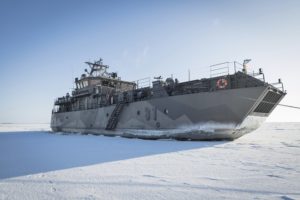
Following the approval of the ‘Squadron 2020’ Project by the Government on
19 September, the Finnish Defence Forces’ Logistics Command formally signed the contracts for a total value of some €1,325M in Turku on 26 September. A €647.6M contract is awarded to the Finnish RAUMA Marine Constructions Oy (RMC) Shipyard, for the design and construction of the units. The hulls will be built by RMC’s subsidiary RMC Defence Oy. The Finnish company AKER ARCTIC Technology Oy signed a €27M contract for the design, development and integration of the special propellers and propeller shafts. Key issue with the propellers is the requirement of a small diameter due to limited draught, slow turning speed due to the sound signature, and high vessel speed. And a €412M contract goes to the Swedish company SAAB for the supply of its 9LV combat management system, the CEROS 200 radar/electro-optical director, a Saab Naval Laser-Warning System, the TACTICALL integrated communications system, the TORPED 47 New Lightweight Torpedo system and TRACKFIRE remote weapon station and the Saab Lightweight Integrated Mast. This mast incorporates a SEA GIRAFFE 4A Fixed Face active electronically scanned array radar, optimised for long-range air/surface surveillance and target indication, and the rotating SEA GIRAFFE 1X radar that provides a complementary surface search and air surveillance capability. SAAB will also be responsible for the integration of the combat management system, the radar suites and weapon systems and is mandated to establish service and maintenance capabilities and industrial cooperation arrangements in-country.
The corvettes will also be equipped with a Raytheon RIM-162 Evolved SEASPARROW missile point defence missile system (designated ITO20), the BAE Systems Bofors 57mm Mk 3medium calibre gun, Rheinmetall MASS decoy launchers and the IAI GABRIEL V anti-ship missiles designated as SSM 2020.
The corvettes’ ASW suite will be made up by a bow mounted medium frequency active search and attack sonar as well as a mine avoidance sonar (with Thales and Simrad the leading candidates) and a Kongsberg ST2400 towed array. The contracts for these systems amount to some €238,4M.
The construction of the four corvettes will be staggered over the 2022–2025 period, with the ‘first-of-class‘ scheduled to be delivered by 2026 and all four units anticipated to be fully operational by 2028. The decision to build these new vessels at RMC was based on the shipyard’s longstanding tradition and experience of supplying combat vessels for the Finnish Navy and, most importantly, to ensure in-country supply and sustain domestic shipbuilding capability. Due to security reasons, the corvettes will be built in separate locations, away from the shipyard’s commercial vessels. A new vehicle and passenger ferry for the Vaasa-Uumaja route is currently under construction.
With a life expectancy well into the 2050s, these multi-role combatants will form the backbone of Finland’s maritime defence.Going to be one of the world’s most modern and advanced platforms, they will set a new era in terms of operational readiness, weapon and sensor suites. Obviously, this will have an impact on the Navy’s Concept of Operations (CONOPS). The sea service is already modifying and updating its CONOPS in order to ensure the optimal use of these new units.
 Cooperation and Partnerships
Cooperation and Partnerships
The dense level of maritime traffic in the Baltic Sea and the Gulf of Finland requires an increased focus on maritime surveillance and safety. However, these security challenges cannot be mastered by any navy alone. As a consequence, the Finnish Navy is enhancing its co-operation with its international partners in order to bundle our competences in the different warfare areas. With the Scandinavian and Nordic countries continuing to play important roles, particularly with regard to the High North, Finland is deepening its defence ties. International cooperation has become an integral part of the navy´s way of operating.
Finland joined the NATO Partnership for Peace programme in 1994 and the EU and the CSDP Defence cooperation the following year. Other steps taken to enhance cooperationwith neighbouring countries and regional partners are projects such as the Surveillance Cooperation Finland-Sweden, the UK-led Joint Expeditionary Force Concept, the Maritime Surveillance, the maritime Surveillance Cooperation Baltic Sea Project and the Nordic Defense Co-operation.
The navy is getting even more engaged in joint international exercises in the region, in particular with the Nordic neighbours and NATO forces. The sea service also became more engaged in multi-national exercises organized in the region, such as the NATO’s ‘Baltops’ exercise since 1993 and in the ‘Northern Coasts’ series from 2007 onwards. This type of manoeuvre allows the navy to compare itself with other European and NATO navies.
Like several other European navies, the Finnish Navy also pools its assets. In 2014, having close cooperation with the Swedish Navy for many years, both navies announced their intention to take their cooperation even further, revealing the Swedish-Finnish Naval Task Group Concept.

After participation in Exercise ‘Northern Coats 2017’, the task group reached its Initial Operational Capability (IOC) and is to attain Full Operational Capability ( FOC) by 2023.
As cyber-defence is a priority in all military domains, not least for the world’s navies, the Finnsh Naval Staff is well aware of the evolving risks in the cyber domain. Finland signed a cyber-defense agreement with NATO to improve situational awareness, capabilities, detection of cyber incidents and resilience to disruptions in information networks. And, in May 2018, Finland, Sweden and the US signed a letter pledging to increase planning and organized joint exercises.
Conclusion
With the comprehensive modernisation programmes ahead, the Finnish Navy will be able to better respond to the new arising security situations. However, it is important to set a clear course to guarantee the relevance of the navy in the longer term. Numbers do matter and exploring new technologies – such as unmanned systems, robotics, sensors, artificial intelligence and communications systems – can help maintain that edge.
Guy Toremans is a freelance naval journalist based in Belgium.






